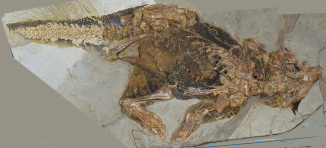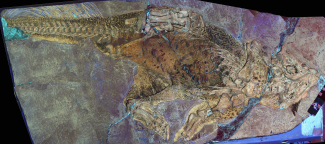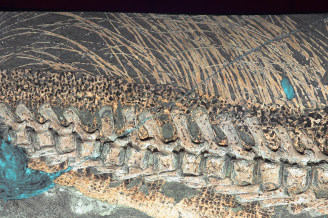Media
HKU Earth scientist and collaborators use cutting edge laser-based technology to clarify early Triceratops relative colour and structure
16 Sep 2016
Dr Michael Pittman (@PalaeoPittman), Research Assistant Professor from the University of Hong Kong’s Department of Earth Sciences, in collaboration with Thomas G Kaye of the Foundation for Scientific Advancement used a cutting edge laser-based imaging technique to help produce the most detailed colour reconstruction of a dinosaur to date. The 120-million-year-old early Triceratops relative Psittacosaurus is known from hundreds of specimens ranging from hatchlings to adults but this study focused on the specimen with the best soft tissue preservation. The new research led by Dr Jakob Vinther of the University of Bristol is published today (September 16) in Current Biology and reveals that Psittacosaurus had a lighter underside relative to its top. This ‘countershading’ suggests that Psittacosaurus was able to disguise its 3D shape and improve its camouflage because it counteracts the pattern of shadow cast by the body under sunlight. The boundary of the lighter underside and darker top is at a low level on the body, matching the pattern found in living animals that live in closed habitats with more diffused light conditions like forests (as opposed to open habitats like savannah with more direct sunlight). This fits with the known forest habitat of Psittacosaurus, suggesting that countershading was used by dinosaurs in the same way as living animals.
Dr Pittman and Mr Kaye’s laser-based imaging, known as laser-stimulated fluorescence or LSF imaging, reveals the colour patterns of Psittacosaurus better than ever before due to the scales of the skin fluorescing brightly. The imaging also helped to clarify the lighter colour of the belly scales which is obscured by dark melanin pigment (which colours our skin and hair) that possibly leaked from internal organs during the animal’s decomposition. The LSF principle involves photons from the laser interacting with atoms in the minerals of the fossil and then losing energy that is released as a different colour photon – it fluoresces. The technique provides an instant chemical map of a fossil that often reveals anatomical information that is invisible under normal lighting. The Psittacosaurus in the paper also preserves some strange long bristles on the tail which the LSF imaging shows has a similar fluorescent colour to the preserved skin. The authors attribute this to calcium phosphate salts that were incorporated into the keratin of the animal’s scales and bristles.
In a separate paper published at the end of August, Gerald Mayr of the Senckenberg Museum of Natural History in Frankfurt, Germany teamed up with Dr Pittman, Mr Kaye and Dr Vinther and his student Evan Saitta to describe the tail bristles in unparalleled detail. They revealed that they are arranged in bundles and possess a pulp that widens towards their base. Thinner variations of these structures are found in two other ornithischian dinosaur species but their anatomy has yet to be studied in detail with the new technique. The similarity of the Psittacosaurus to the spine and filaments of some modern birds that are not true feathers makes it uncertain if the diversity of skin-based structures in dinosaurs evolved from the same common structure(s) in the first dinosaurs. However, the team’s results make important steps towards answering this extensively debated question.
Papers:
Vinther, J., Nicholls, R., Lautenschlager, S., Pittman, M., Kaye, T. G., Rayfield, E., Mayr, G. and Cuthill, I. C. 2016. 3D Camouflage in an Ornithischian Dinosaur. Current Biology. http://dx.doi.org/10.1016/j.cub.2016.06.065
Mayr, G., Pittman, M., Saitta, E., Kaye, T.G. & Vinther, J. Structure and homology of Psittacosaurus tail bristles. Palaeontology, 1-10.
http://dx.doi.org/10.1111/pala.12257
For media enquiries, please contact Ms Cindy Chan, Senior Communication Manager of HKU Faculty of Science (tel: 3917 5286/ 6703 0212; email: cindycst@hku.hk ).
Photo of Psittacosaurus sp. SMF R 4970 under cross polarised light. The specimen is housed at the Senckenberg Museum of Natural History in Frankfurt, Germany. Credit: Jakob Vinther.




